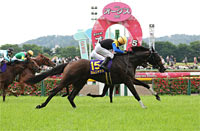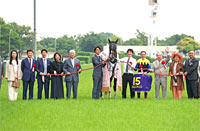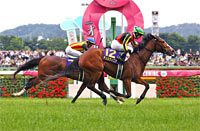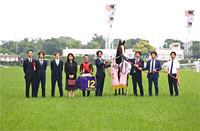Yushun Himba (Japanese Oaks) (G1) - Data Analysis
Second fillies classic in which ability to cope with unfamiliar distance is key
Many of the runners in the Yushun Himba (Japanese Oaks) do not have experience in 2,400m races, and therefore contest this race over an unfamiliar distance. While dark horses have snatched the spoils in the past, the race has unfolded more or less in line with expectations in recent years. Over the last ten years, runners backed as 3rd favorite or higher have achieved eight victories, and race favorites have triumphed in the five consecutive years from 2016 to 2020. The question is whether this pattern will repeat this year. Let’s now analyze some trends in the Japanese Oaks based on data for the last 10 years.
Runners starting in inner brackets have the edge thanks to smaller distance disadvantage
It is well known that runners starting in the inner brackets perform well in the Tokyo Yushun (Japanese Derby), and the same is true for the Japanese Oaks, which is contested on the same course. The distance until the first corner is short, at roughly 350m, and runners starting in the inner brackets tend to perform well thanks to the smaller distance disadvantage derived from their position along the inside rail. There are many examples of strong performance by such runners, including 2020 winner Daring Tact (bracket 2, horse number 4), 2019 third-place finisher Chrono Genesis (bracket 1, horse number 2), and 2018 runner-up Lily Noble (bracket 1, horse number 1) and third-place finisher Lucky Lilac (bracket 1, horse number 2). In 2017, the two runners starting in bracket 1 occupied the Top 2. In other words, we should keep a close eye on runners starting in the inner brackets. [Table 1]
[Table 1] Performance by bracket number (last 10 years)
| Bracket number |
Performance
[1st-2nd-3rd-4th or lower] |
Win ratio |
Top 2 ratio |
Top 3 ratio |
| 1 |
1-2-2-15 |
5.0% |
15.0% |
25.0% |
| 2 |
4-0-1-13 |
22.2% |
22.2% |
27.8% |
| 3 |
0-0-2-18 |
0% |
0% |
10.0% |
| 4 |
0-0-1-19 |
0% |
0% |
5.0% |
| 5 |
2-3-0-15 |
10.0% |
25.0% |
25.0% |
| 6 |
0-0-1-19 |
0% |
0% |
5.0% |
| 7 |
3-3-1-23 |
10.0% |
20.0% |
23.3% |
| 8 |
0-2-2-26 |
0% |
6.7% |
13.3% |
No winners among heavy and light horses
Among the last 10 winners, the heaviest horse was Meisho Mambo at 478kg in 2013 and the lightest horse was Sinhalite at 422kg in 2016. As shown in Table 2, runners with a weight of 460kg-479kg achieved high success ratios, while heavy horses with a weight of 480kg or higher and light horses with a weight under 420kg delivered lackluster performance. Incidentally, the 75 runners with a weight of 480kg or higher that have entered the race since 1986 have produced only one winner: Kawakami Princess (484kg) in 2006. The last runner with a weight under 420kg to win the race was Adorable in 1992 (410kg). [Table 2]
[Table 2] Performance by body weight (last 10 years)
| Body weight |
Performance
[1st-2nd-3rd-4th or lower] |
Win ratio |
Top 2 ratio |
Top 3 ratio |
| 419kg or lower |
0-0-1-14 |
0% |
0% |
6.7% |
| 420kg-439kg |
2-2-2-30 |
5.6% |
11.1% |
16.7% |
| 440kg-459kg |
3-2-2-56 |
4.8% |
7.9% |
11.1% |
| 460kg-479kg |
5-5-3-30 |
11.6% |
23.3% |
30.2% |
| 480kg or higher |
0-1-2-18 |
0% |
4.8% |
14.3% |
Runners coming from Oka Sho are top contenders, but those coming from Wasurenagusa Sho also warrant attention
When analyzing performance by previous race, we find that many runners have come from the Oka Sho (Japanese 1000 Guineas). Runners in this group have also produced the highest number of winners (seven). Runners coming from the Wasurenagusa Sho, although fewer in overall number, have produced the second highest number of winners (three). Runners coming from the Sankei Sports Sho Flora Stakes (Japanese Oaks Trial) have produced runners-up and third-place finishers but no winners, while runners coming from the Sweet Pea Stakes or other races have not enjoyed much success. When planning bets, we should therefore concentrate on runners coming from either the Oka Sho or the Wasurenagusa Sho. [Table 3]
[Table 3] Performance by previous race (last 10 years)
| Previous race |
Performance
[1st-2nd-3rd-4th or lower] |
Win ratio |
Top 2 ratio |
Top 3 ratio |
Oka Sho
(Japanese 1000 Guineas) |
7-4-5-63 |
8.9% |
13.9% |
20.3% |
| Wasurenagusa Sho |
3-0-1-7 |
27.3% |
27.3% |
36.4% |
| Sankei Sports Sho Flora Stakes (Japanese Oaks Trial) |
0-5-3-37 |
0% |
11.1% |
17.8% |
| Sweet Pea Stakes |
0-1-0-16 |
0% |
5.9% |
5.9% |
| Other race |
0-0-1-25 |
0% |
0% |
3.8% |
Focus on runners that delivered a final sprint in the Oka Sho
When considering runners coming from the Oka Sho, we should analyze their ranking in terms of the estimated time over the final three furlongs in that race. Runners in this group that were ranked third or higher in terms of the estimated time over the final three furlongs, achieved an excellent Win ratio of 23.8% and Top 3 ratio of 47.6%. In contrast, runners ranked 4th or lower had significantly lower success ratios. This is probably attributable to the long homestretch of Tokyo Racecourse, which is conducive to a final sprint. Incidentally, the Top 3 runners by the estimated time over the final three furlongs in the 2021 Oka Sho were Satono Reinas (32.9s), Kukuna (33.2s), and Fine Rouge (33.7s). [Table 4]
[Table 4] Among runners coming from the Oka Sho, performance by ranking in terms of estimated time over final three furlongs in that race (last 10 years)
| Ranking |
Performance
[1st-2nd-3rd-4th or lower] |
Win ratio |
Top 2 ratio |
Top 3 ratio |
| 3rd or higher |
5-2-3-11 |
23.8% |
33.3% |
47.6% |
| 4th or lower |
2-2-2-52 |
3.4% |
6.9% |
10.3% |
Need to discount horses with a change of jockey
In the Japanese Oaks over the last 10 years, runners with a change of jockey from the previous race have only produced one winner: 2012 winner Gentildonna (jockey changed from Yasunari Iwata to Yuga Kawada). In this particular case, the jockey was changed abruptly after Iwata had been temporarily suspended. This suggests we should slightly discount runners with a change of jockey from the previous race. [Table 5]
[Table 5] Performance by jockey in previous race (last 10 years)
| Jockey in previous race |
Performance
[1st-2nd-3rd-4th or lower] |
Win ratio |
Top 2 ratio |
Top 3 ratio |
| Same jockey |
9-7-8-91 |
7.8% |
13.9% |
20.9% |
| Different jockey |
1-3-2-57 |
1.6% |
6.3% |
9.5% |
Seek out the winner!
Three or more straight wins a key point
Nine of the last 10 winners had achieved straight wins before entering the Japanese Oaks. In addition, the last five winners had all notched three or more straight wins (including first win): Sinhalite (newcomer → Kobai Stakes → Tulip Sho), Soul Stirring (newcomer → Ivy Stakes → Hanshin Juvenile Fillies → Tulip Sho), Almond Eye (maiden → Nikkan Sports Sho Shinzan Kinen → Oka Sho), Loves Only You (newcomer → Shiragiku Sho → Wasurenagusa Sho), Daring Tact (newcomer → Elfin Stakes → Oka Sho). In other words, it would seem a good idea to keep an eye on runners with three or more consecutive victories. [Table 6]
[Table 6] Winners and straight wins (last five years)
| Year |
Winner |
Straight wins |
| 2016 |
Sinhalite |
3 straight wins |
| 2017 |
Soul Stirring |
4 straight wins |
| 2018 |
Almond Eye |
3 straight wins |
| 2019 |
Loves Only You |
3 straight wins |
| 2020 |
Daring Tact |
3 straight wins |
(Yodohito Himezono)
|



















